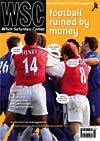 India is a potential superpower of Asian football, but huge support has not been matched by dynamic leadership on the subcontinent. Dan Brennan reports
India is a potential superpower of Asian football, but huge support has not been matched by dynamic leadership on the subcontinent. Dan Brennan reports
Last month Brazilian goal-machine Barreto scored the only goal in a fiercely fought local derby in front of 120,000 fans. Next month he will be lining up against Shevchenko. He plays not at the Maracana or the San Siro, but at the Saltlake Stadium in Calcutta, where his team McDowell Mohun Bagan were taking on East Bengal in the opening game of India’s sixth National League season. While cricket may hog the media limelight and the sponsors’ money, in many parts of India, such as Bengal, Goa and Kerala, football is the main sporting obsession. In one half of India’s second city, Barreto is a cult figure.
The 25-year-old arrived in India two seasons ago via the J-League. Signed to help break East Bengal’s traditional dominance, he scored 14 goals last season, and while East Bengal retained the title, he helped Mohun lift the Durand Cup – the world’s second oldest knockout trophy. All but three of the 12 National League sides now have overseas players on their books. Mohun have three other Brazilians this season, while in Portuguese-speaking Goa, Vasco and Churchill provide a home from home for several more. Elsewhere, most of the foreigners are young Africans and east European mavericks (the Shevchenko in question is Mykola, a much-travelled Ukrainian and no relation of Andrei). FC Kochin, India’s only fully professional team, have brought in five players from Liberia, while East Bengal have turned this season to a mixture of Nigerians and Ghanaians
While this influx has undoubtedly given a new impetus to the domestic game, football in India is plagued with problems. During its heyday in the Fifties the national side was regarded as one of the top teams in Asia (in 1956 they beat Australia 7-1 away) but has since lapsed into mediocrity. A notable victory against regional heavyweights UAE in the 2002 World Cup qualifiers merely emphasised India’s inability to make consistent progress.
In 1950, they were invited to play in the World Cup, but the AIFF, the game’s ruling body, bizarrely insisted that the players play barefoot, while FIFA demanded footwear, so the invitation was declined. Many argue that the approach of those who govern the game in India has not progressed since.
Japan, China, Thailand and even Nepal have seen their fortunes lifted with a western coach at the helm, prompting calls for India to follow suit. But in truth the problems are more fundamental. Where the game in other countries has attracted strong commercial and media backing and has been fully professionalised, in India it is dominated by an antiquated state-run bureaucracy, riddled with political infighting and tarnished by constant allegations of corruption and money-laundering.
Bill Adams, an Englishman who runs the Indian Youth Soccer Association, confirms: “People say that Indian players are not up to the mark, or the coaching is antiquated, or that the inept self-seekers who run the game are to blame, but these are symptoms of the basic problem. The problem is the entire structure of football in India.” His views are echoed by Danny Maclennan, who once played for Rangers and spent a few seasons coaching Goan club Churchill. “Indian football,” he says, “is like a racing car with flat tyres and a damaged engine.” In other words, the huge potential and enthusiasm for the game is wasted because it is run by amateurs.
The National League, hailed on its formation as a big step forward, is still forced to play second fiddle to myriad regional leagues and meaningless cup competitions. As many of the teams are affiliated to government departments or state-owned companies, who control the leagues, there is in-built resistance to phasing them out. So the National League is crammed into a three-month period, with erratic scheduling and poor TV coverage. As a result, first Philips and then Coca-Cola have packed their bags in despair.
While Barreto can command a salary of around £50,000 – a fortune by local standards – most local footballers have to hold down jobs in the civil service in order to maintain their club places. Even IM Vijayan, one of India’s most feted players and the former captain of the national team, has had to double up as a policeman throughout his career.
When the national captain Baichung Bhutia joined Bury two seasons ago, there was a huge wave of expectation that this was a sign of things to come. However, India’s football icon has failed to make much of an impact at Gigg Lane, and last summer’s tour of England by the national side, where they struggled against Second Division opponents, shows just how far they have to go.
Many are losing patience with the AIFF’s inability to take the game forward. A UK-based agency, Strata, has just been appointed as market-ing agent for the National League and Federation Cup. Strata, which already has the rights to market Vietnamese football, has guaranteed to pay the AIFF several million dollars over the next five years. However, it remains to be seen how wisely the AIFF uses these potentially mould-breaking funds.
From WSC 181 March 2002. What was happening this month